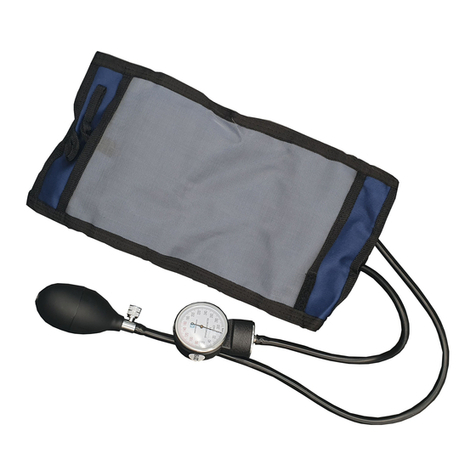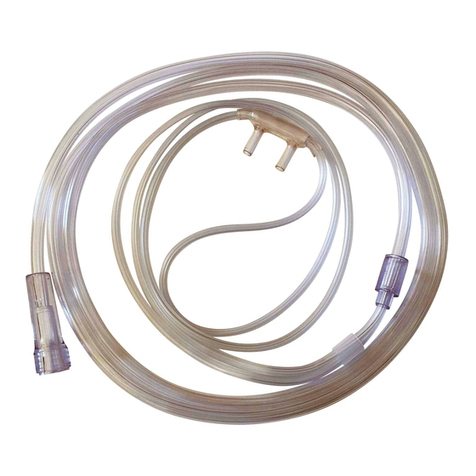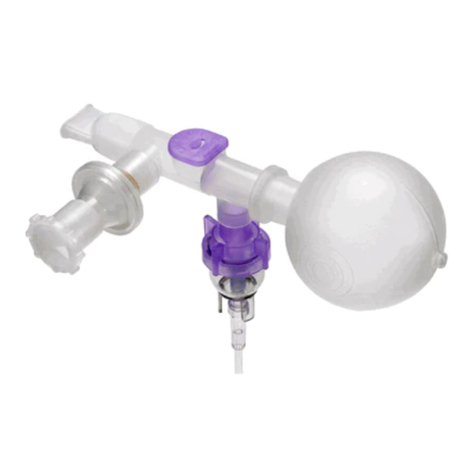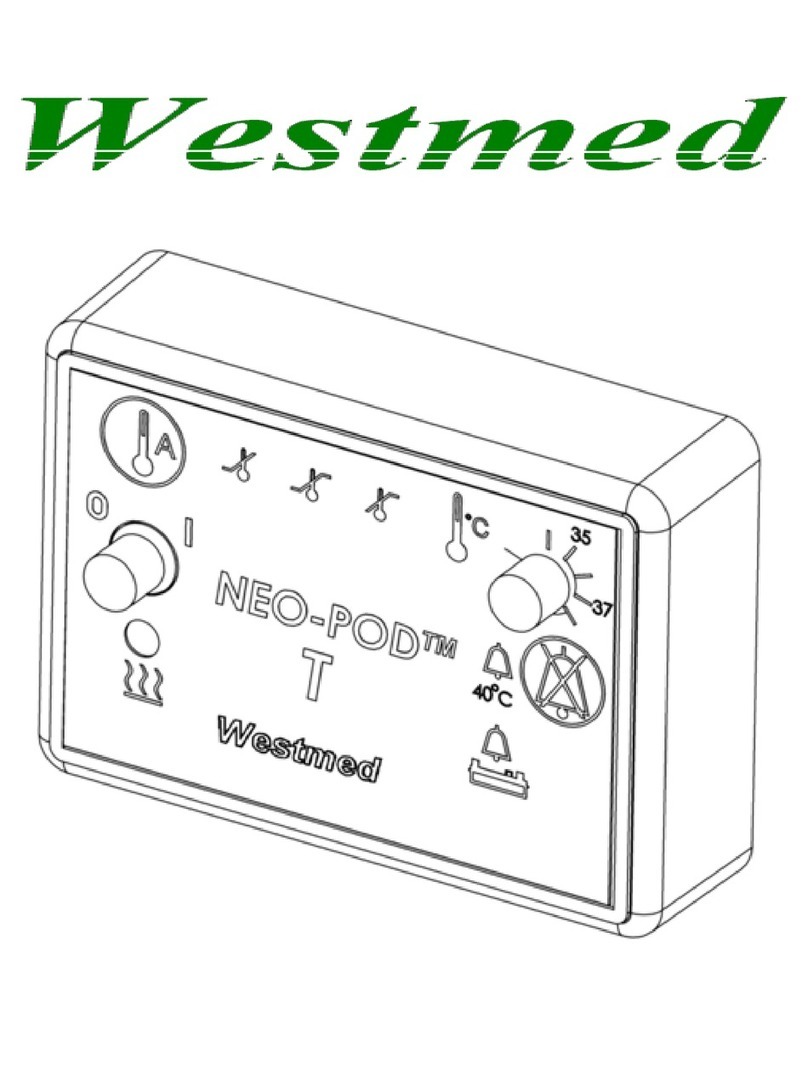
4 5
•
Classification of protection: Class II
• Type of applied part: BF (Breathing tubes and patient-end connectors)
• Protection from ingress of water: none IPXØ
• Mode of operation: capable of continuous operation
•
interference between this device and other known devices
No known potential for adverse effects from electromagnetic or other
• No known adverse effects on the performance of the humidification
system when exposed to electrocautery, electrosurgery,
defibrillation, X-ray (gamma radiation), infrared radiation, conducted
transient magnetic fields including magnetic resonance imaging (MRI),
and radiofrequency interference.
Gross Dimensions of Controller:
•Weight – 540 g (1.19lbs)
•Height – 102 mm (4.0”)
•
•Width – 82.5 mm (3.25”)
Displayed Delivered at ET tube
C°43C°73
C°73C°14
C°04C°54
Controls:
Alarm Silence button: Silences the audible alarm for 2 minutes.
Alarms:
Classification according to IEC 60601-1
Length – 123 mm (4.85”)
Manufactured by Westmed, Inc. 5580 S. Nogales Highway Tucson, AZ 85706 USA Manufactured by Westmed, Inc. 5580 S. Nogales Highway Tucson, AZ 85706 USA
Specifications:
•Input Voltage: 120VAC +/- 10%, single phase, 50 – 60Hz for Domestic (A2003-1)
240VAC +/- 10%, single phase, 50 – 60Hz for International (A2003)
•Input Current: 2.0A AC rms for Domestic (A2003-1) (maximum at 12 Liters / Minute and 45°C.)
1.0A AC rms for International (A2003) (maximum at 12 Liters / Minute and 45°C.)
•Output Power – 50W max
•Current leakage: Double insulated, Designed to meet UL 544.
•Output Temperature Range: 34°C to 45°C (+/- 0.5°C) @95%+ R.H. (99% certainty)
•Maximum output temperature: 47.5°C
•Minimum Humidification output: 37mg H2O / Liters/Minute (at 34°C)
•Maximum Humidification output: 65mg H2O / Liters/Minute (at 45°C)
•Input Flow rate: 12 Liters per minute maximum
•Warm up time: 15 min maximum
•Maximum system operating pressure: 70cmH2O
•Operating Temperature Range:16°C to 45°C (9,500-ft or less)
•Gas Inlet Temperature Range: 16°C to 45°C
•While packed for transport or storage, equipment is capable of being
exposed to a temperature range of -20˚C to +60˚C, 15% to 90% R.H.(9,500-ft or less)
O I On/Off switch: Turns the power on and off for both ANAPODTM
Humidification System and heated wick circuit
Temperature Controls buttons: Sets the desired temperature.
Over Temperature Alarm: Indicates the wick circuit internal
temperature probe has detected temperature at above 47.5° C.
Probe Sensor Alarm: Indicates a probe failure or circuit disconnect.
Temperature Measurement:
The ANAPODTM uses one temperature sensor which is located inside each heated
wick circuit. There are no external probes to attach. This probe is calibrated to
measure the temperature of the flowing gas at the patient end of the wick circuit.
As with all heated systems, there is a certain drop in temperature in unheated
wyes, elbows, and ET tubes. You can expect a temperature drop of approximately
4 - 5º C from the wick circuit outlet to the inlet of the ET tube under normal operating
room conditions. It may be necessary to overcome heat loss in the last few non
heated inches of the tubing, cuff, patient wye, elbow and/or ET tube. You may also
need to compensate for ambient temperatures and/or low airflows. Using the
ANAPODTM Humidification System outside of the operating temperature range of
16º C to 45º C has the potential to affect perfomance. It is recommended that it be
kept within this temperature range during use. Testing shows the following typical
temperature drops between wick circuit output and ET tube:
•Power cord third conductor is only a functional earth
•Gas Path Resistance: 0 to 0.06 cmH2O / Liters/Minute (at maximum flow rate)
•Gas Path Compliance: 2.5 to 2.8 mL/cmH2O
(To test this alarm, disconnect cable while controller is ON.)
All alarms generate both a visual indication and an audible alarm,
and are Low Priority alarms. The audible alarm can be silenced for
2 minutes by pressing the Alarm Silence button; however, the alarm
LED will remain illuminated as long as the alarm condition exists. As
a reminder, audible alarm will initiate again if condition is not resolved.
All alarms will disable the heater in the wick circuit.


































